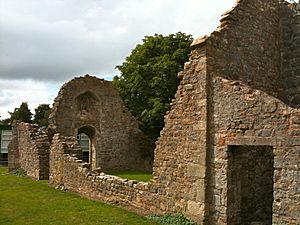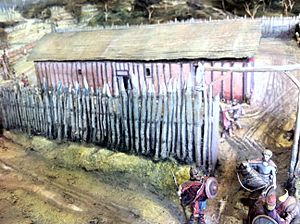Cheddar Palace facts for kids
Quick facts for kids Cheddar Palace |
|
|---|---|

The ruined St Columbanus Chapel
|
|
| Location | Cheddar, Somerset, England |
| Official name: Roman settlement site, Anglo-Saxon and Norman royal palace, and St Columbanus' Chapel | |
| Designated | 16 December 1999 |
| Reference no. | 1017290 |
|
Listed Building – Grade II
|
|
| Official name: Former chapel dedicated to St Columbanus | |
| Designated | 29 January 1985 |
| Reference no. | 1173737 |
| Lua error in Module:Location_map at line 420: attempt to index field 'wikibase' (a nil value). | |
The Cheddar Palace was an important royal building in Cheddar, Somerset, England. It was first built around the 800s. For many years, it served as a special hunting lodge for kings and queens. It was used during both the Anglo-Saxon times and the Middle Ages. Important meetings called the Witenagemot were held here in the 900s.
Today, you can still see the ruins of the St Columbanus Chapel nearby. Also, old Roman objects and even a burial have been found at the site. The spot where the palace once stood is now marked with concrete slabs at The Kings of Wessex Academy.
Contents
History of Cheddar Palace
The first main building at Cheddar was a large wooden hall. It was built around the time of King Alfred the Great (who died in 899 AD). King Alfred even mentioned the "community at Cheddar" in his will. At first, this building was a type of church called a minster.
Around 930 AD, the palace was rebuilt. A chapel and other buildings were added. It then became a royal hunting lodge, a place where kings could stay when they went hunting.
Royal Meetings at the Palace
During the Anglo-Saxon period, the palace was used for important meetings. These meetings were called the Witenagemot. Powerful people would gather there to discuss important matters. These meetings happened in 941, 956, and 968 AD. Kings like Æthelstan and Edgar the Peaceful likely used the palace for these gatherings.
Later, during the Norman period, kings continued to visit. We know that King Henry I visited the palace in 1121 and 1130. King Henry II also visited in 1158. The palace was made bigger several times between the Saxon and medieval eras.
What Happened to the Palace?
In 1230, the palace site was given to the church leaders of Wells Cathedral. Much later, in 1548, it was sold to King Edward VI.
The remains of the palace were dug up by archaeologists when the school was being built. After studying them, the remains were buried again to protect them. The exact layout of the palace is now shown by concrete markers on the ground.
St Columbanus Chapel
Next to where the palace stood, you can find the ruins of a chapel. This chapel was built in the 1300s and was dedicated to St. Columbanus.
The chapel stands on a spot where a building was first put up in the 900s. It was made larger in the 1000s. In the 1600s, it became a private house. This house lasted until 1910.
The chapel had an interesting eight-sided shape. Some of its end walls are still standing. They are held up by strong diagonal supports called buttresses. The north and south walls are now only about 1 metre (3 ft 3 in) high.
Roman Discoveries
In January 2006, during the building of a new part of the school, something exciting was found. A grave, thought to be from Roman times, was uncovered. Inside the grave was the skeleton of a man. Experts believe he was about 50 years old. His grave was placed north-south, which suggests he was not Christian.
Many other Roman objects have also been found. These include pieces of wall plaster and small tiles called tesserae. These items date from the 1st to the 4th centuries. Some people think these finds might be linked to an ancient Roman settlement called Iscalis, but its exact location is still a mystery.
Images for kids
See also
 In Spanish: Palacio de Cheddar para niños
In Spanish: Palacio de Cheddar para niños






